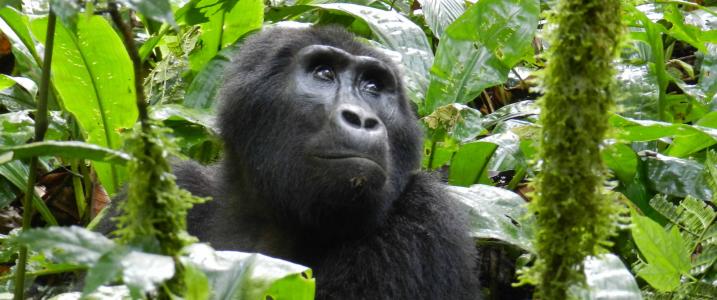The decline of the world’s large herbivores, especially in Africa and parts of Asia, is raising the specter of an “empty landscape” in some of the most diverse ecosystems on the planet, according to a newly published study.
Many populations of animals such as rhinoceroses, zebras, camels, elephants and tapirs are diminishing or threatened with extinction in grasslands, savannahs, deserts and forests, scientists say.
An international team of wildlife ecologists led by William Ripple, Oregon State University distinguished professor in the College of Forestry, conducted a comprehensive analysis of data on the world’s largest herbivores (more than 100 kilograms, or 220 pounds, on average), including endangerment status, key threats and ecological consequences of population decline. They published their observations today in Science Advances, the open-access online journal of Science magazine.
The authors focused on 74 large herbivore species – animals that subsist on vegetation – and concluded that “without radical intervention, large herbivores (and many smaller ones) will continue to disappear from numerous regions with enormous ecological, social, and economic costs.” Ripple initiated the study after conducting a global analysis of large-carnivore decline, which goes hand-in-hand, he said, with the loss of their herbivore prey.
“I expected that habitat change would be the main factor causing the endangerment of large herbivores,” Ripple said. “But surprisingly, the results show that the two main factors in herbivore declines are hunting by humans and habitat change. They are twin threats.”
The scientists refer to an analysis of the decline of animals in tropical forests published in the journalBioScience in 1992. The author, Kent H. Redford, then a post-doctoral researcher at the University of Florida, first used the term “empty forest.” While soaring trees and other vegetation may exist, he wrote, the loss of forest fauna posed a long-term threat to those ecosystems.
Ripple and his colleagues went a step further. “Our analysis shows that it goes well beyond forest landscapes,” he said, “to savannahs and grasslands and deserts. So we coin a new term, the empty landscape.” As a group, terrestrial herbivores encompass about 4,000 known species and live in many types of ecosystems on every continent except Antarctica.
The highest numbers of threatened large herbivores live in developing countries, especially Southeast Asia, India and Africa, the scientists report. Only one endangered large herbivore lives in Europe (the European bison), and none are in North America, which, the authors add, has “already lost most of its large mammals” through prehistoric hunting and habitat changes.
The authors note that 25 of the largest wild herbivores now occupy an average of only 19 percent of their historical ranges. Competition from livestock production, which has tripled globally since 1980, has reduced herbivore access to land, forage and water and raised disease transmission risks, they add.
Meanwhile, herbivore hunting occurs for two major purposes, the authors note: meat consumption and the global trade in animal parts. An estimated 1 billion humans subsist on wild meat, they write.
Read more: Global decline of large herbivores may lead to an “empty landscape,” scientists say
The Latest on: Decline of large herbivores
[google_news title=”” keyword=”Decline of large herbivores” num_posts=”10″ blurb_length=”0″ show_thumb=”left”]
via Google News
The Latest on: Decline of large herbivores
- Low-intensity grazing is locally better for biodiversity but challenging for land users, study showson April 30, 2024 at 1:44 pm
A team of researchers led by the German Centre for Integrative Biodiversity Research (iDiv), Leipzig University (UL), and the Helmholtz Centre for Environmental Research (UFZ) has investigated the ...
- Extensive study of beavers reveals environmental impact of reintroductionon April 30, 2024 at 1:08 pm
As beaver populations rise, interactions with deer are expected to become more common in riparian woodlands, which are valued for their role in reducing pollution to rivers, shading them from rising ...
- Woolly Mammoths In Yellowstone? Biotech Company Says It Has The Technologyon April 27, 2024 at 8:58 am
Biotech company Colossal Biosciences has announced plans to bring back the extinct woolly mammoth by 2028. They think Yellowstone could be a good place for reintroduction as the environment is ...
- World Tapir Day: What Happens When Dogs Meet Tapirs?on April 27, 2024 at 5:00 am
Researchers have documented conflict between between a tapir and a dog in Mexico, highlighting the impact of encroaching human settlement on this living fossil species.
- Argentine scientists find speedy 90-million-year-old herbivore dinosauron April 25, 2024 at 1:30 pm
Paleontologists from Argentina announced the discovery of a new medium-sized herbivorous dinosaur, which was a fast runner and lived about 90 million years ago in the Late Cretaceous period in present ...
- Climate change could become the main driver of biodiversity decline by mid-century, analysis suggestson April 25, 2024 at 11:00 am
Global biodiversity has declined between 2% and 11% during the 20th century due to land-use change alone, according to a large multi-model study published in Science. Projections show climate change ...
- The Waning Reign of the Wetland Architect We Barely Know (Hint: Not a Beaver)on April 23, 2024 at 12:08 am
They are prolific breeders, raising a dozen or more young per year in times of plenty, as happy and quick to set up house along a drainage ditch as in a wetland sanctuary. Even as other so-called ...
- Yellowstone’s Wolves: A Debate Over Their Role in the Park’s Ecosystemon April 22, 2024 at 11:59 pm
New research questions the long-held theory that reintroduction of such a predator caused a trophic cascade, spawning renewal of vegetation and spurring biodiversity.
- More than coral: The unseen casualties of record-breaking heat on the Great Barrier Reefon April 22, 2024 at 8:38 am
In past bleaching events on the Great Barrier Reef, the southern region has sometimes been spared worst of the bleaching. Not this time. This year's intense underwater heat has triggered the most ...
- Out on dry land: Water shortage threatens species in Ruaha National Park in Tanzaniaon April 15, 2024 at 10:15 am
Climate change is not the only cause of arid landscapes. A research team led by the Leibniz Institute for Zoo and Wildlife Research (Leibniz-IZW) has investigated the consequences of increased water ...
via Bing News










